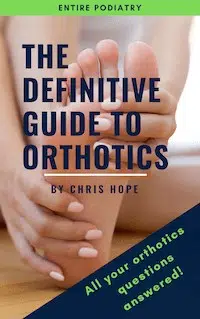Pain across the top of the foot is a common complaint that we treat. There is quite a lot of anatomy in this area including tendons, joints, ligaments, bones and muscles and any one of these structures can be susceptible to injury causing pain.
Pain across the top of the foot can also be due to improper shoes. For example shoes that don’t provide enough support can cause the top of the foot to get compressed. Even shoes that are tied too tightly or have irritating and poorly located seams or liners can cause pain and discomfort along the top of your foot.
Click on the link below for more information about some of the more common causes of pain on the top of your foot.
The most common causes of pain on the top of the feet are as follows:
- Midfoot arthritis
- Stress fractures
- Metatarsalgia
- Nerve entrapment
- Extensor tendinopathy
- Dorsal midfoot interosseous compression syndrome
Midfoot arthritis
The midfoot or the “bridge” of your foot is comprised of a complex arrangement of many bones and joints. These joints are susceptible to the development of arthritis. Midfoot arthritis usually involves swelling and pain across the top of the foot. The pain tends to get worse with prolonged standing or walking and can also be irritated by footwear pressing against the top of the foot. Sometimes the bones in this area can thicken and a bony bump or spur can develop. Read more about Midfoot arthritis.
Whilst there is yet to be a ‘cure’ for arthritis of any kind, recent evidence has been published which shows that foot orthotics may be effective in the treatment of symptomatic midfoot arthritis. Orthotics provide support and stability to the bones and joints across the midfoot by supporting the arch from underneath the foot. This support and stability assists in the management of midfoot arthritis pain. For information on foot orthotics, click here. Or contact us to arrange a consultation or fitting.
Stress fractures
A stress fracture can develop when too much force is applied to a bone over time, causing the bone to gradually weaken leading to an incomplete break. This is different to a regular fracture, which usually develops from a single injury. Stress fractures often occur in runners or people who stand for long periods of time. There will be localised pain and swelling over the fracture site and walking or standing will be painful.
The two most common places for a stress fracture to develop in the foot is the navicular and the second metatarsal. Both of these bones sit close to the top of the foot so pain will usually be felt in this area.
The navicular bone sits on the inside of the foot between the ankle and the midfoot. A stress fracture of the navicular can develop when too much stress is placed on the bone. The navicular also has areas of poor blood flow, which makes it more prone to injury.
A stress fracture of the second metatarsal often causes pain and swelling right in the centre of the foot. Pain will be worse when standing on the toes or wearing high heeled shoes. Read more about stress fractures.
Metatarsalgia
Metatarsalgia is a broad term used to describe pain across the ball off the foot at the metatarsals. A range of conditions can cause metatarsalgia for example, capsulitis, bursitis, Morton’s neuroma, stress fractures, plantar plate injury etc. (we have content written for all of these topics if we want to hyperlink them?)
Most of those conditions cause pain primarily under the midfoot, however this pain can radiate through the foot causing pain to be felt at the top of the foot. Read more about ball of the foot pain – Metatarsalgia.
Nerve entrapment
A rarer condition that can affect the top of the foot is Common Peroneal Nerve Dysfunction. This is a dysfunction of a branch of the sciatic nerve that can cause strange symptoms such as tingling and pain at the top of the foot, along with weakness of the foot or lower leg. This diagnosis should only be reached after a thorough assessment of your symptoms by a health professional.
Extensor tendinopathy
We have what are known as ‘extensor tendons’ that sit on the top of our foot. These tendons originate from a muscle at the front of the shinbone and extend out to the toes. You may be able to see or feel these tendons if you feel across the top of your foot and wiggle your toes around.
These tendons are responsible for lifting feet and toes up, i.e. ‘dorsiflex’ your foot. As with any tendon, they can be a cause of pain and discomfort if a tendinopathy develops. A tendinopathy is inflammation and irritation of the tendon. This is often felt across the top of the foot and pain is usually worse when you lift your feet and toes ‘up’ towards your shinbone.
Dorsal Midfoot Interosseous Compression Syndrome (DMICS)
What is Dorsal Midfoot Interosseous Compression Syndrome (DMICS)?
DMICS is a condition whereby the ligaments along the top of the midfoot are inflamed.
What does DMICS feel like?
The symptoms of DMICS usually include pain on either side of the foot and along the joint lines at the top of the foot (just in front of where the lower leg meets the
foot).
If you have DMICS you may find that the pain is worse when weight-bearing, and just before lifting your heel from the ground during walking. You may also notice that the pain is exacerbated by walking in bare feet or in shoes with low heels.
What causes DMICS?
DMICS is caused by chronic excessive interosseous compression forces through the joints in the top of the midfoot during weight-bearing activities.
Any factors that cause flattening of the arches of the feet can increase these compressive forces. For example, low heeled shoes, a tight Achilles tendon and increased body weight are all factors that can contribute to the development of DMICS. Tight calf muscles can also cause the foot to pronate (roll inward), which can further exacerbate the symptoms of DMICS.
DMICS can occur in all adult age groups, and is more common in females. There may be no history of trauma associated with DMICS.
What is the treatment for DMICS?
DMICS usually responds well to conservative treatment, especially if treatment is commenced early.
Icing and non-steroidal anti-inflammatory medication is often recommended initially to reduce local pain and inflammation. However, effective management requires underlying mechanical causes to be addressed. Depending on your individual circumstances and podiatry assessment, treatment may include:
- A muscle strengthening and stretching exercise program, to address muscle imbalances and reduce tension in the Achilles tendon
- Footwear adjustments such as a heel raise or prescription of a slightly higher heeled shoe can help to prevent collapse of foot arches
- Longer term treatment and prevention is generally best achieved through the use of total contact orthotics which support the whole length of the foot. By preventing collapse of the arches, total contact orthotics can reduce interosseous compression forces through the top of the foot.
Are there any other treatment options for DMICS?
Cortisone injections are sometimes recommended for DMICS. However, a cortisone injection is often not adequate in terms of addressing underlying mechanical causes of DMICS. Surgical treatment options are available, however there are a range of possible complications associated with this type of surgery. Fortunately, conservative treatment is effective in most cases.
Read more about dorsal midfoot interosseous compression syndrome.





